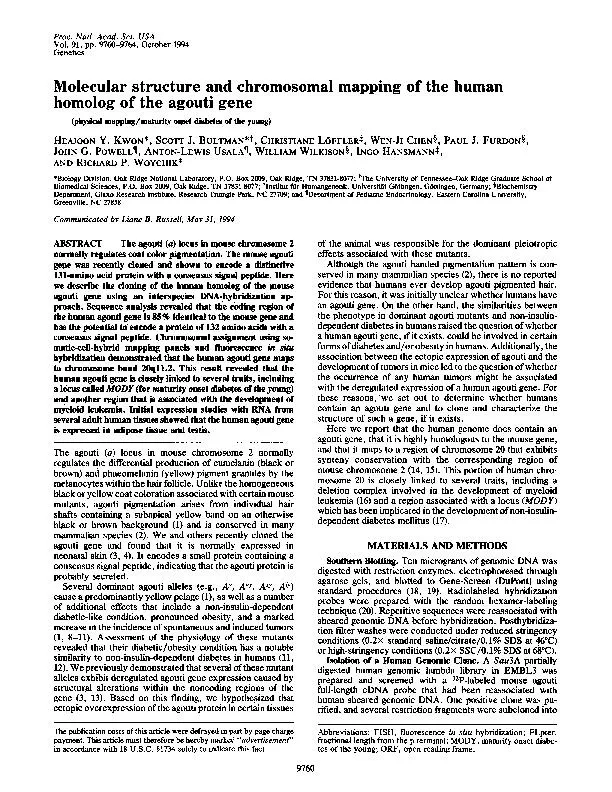

ProcNatAcadSciUSA9119949761thepGEM4vectorPromegaforsequencingSpecificallya12kbPstIfragmentwhichhybridizedtothemousecDNAprobebutnottotalmouseDNAwassubclonedtogeneratethesequencehomologou ID: 311982
Download Pdf The PPT/PDF document "Proc.Natl.Acad.Sci.USAVol.91,pp.9760-976..." is the property of its rightful owner. Permission is granted to download and print the materials on this web site for personal, non-commercial use only, and to display it on your personal computer provided you do not modify the materials and that you retain all copyright notices contained in the materials. By downloading content from our website, you accept the terms of this agreement.
Proc.Natl.Acad.Sci.USAVol.91,pp.9760-9764,October1994GeneticsMolecularstructureandchromosomalmappingofthehumanhomologoftheagoutigene(physicalmapping/maturityonsetdiabetesoftheyoung)HEAJOONY.KWON*,SCOTTJ.BULTMAN*t,CHRISTIANELOFFLERt,WEN-JICHEN§,PAULJ.FURDON§,JOHNG.POWELL¶,ANTON-LEWISUSALA¶,WILLIAMWILKISON§,INGOHANSMANNt,ANDRICHARDP.WOYCHIK**BiologyDivision,OakRidgeNationalLaboratory,P.O.Box2009,OakRidge,TN37831-8077;tTheUniversityofTennessee-OakRidgeGraduateSchoolofBiomedicalSciences,P.O.Box2009,OakRidge,TN37831-8077;tInstitutfurHumangenetik,UniversitatGottingen,Gottingen,Germany;§BiochemistryDepartment,GlaxoResearchInstitute,ResearchTrianglePark,NC27709;andIDepartmentofPediatricEndocrinology,EasternCarolinaUniversity,Greenville,NC27858CommunicatedbyLianeB.Russell,May31,1994ABSTRACTTheagouti(a)locusinmousechromosome2normallyregulatescoatcolorpigmentation.Themouseagoutigenewasrecentlyclonedandshowntoencodeadistinctive131-aminoacidproteinwithaconsensussignalpeptide.HerewedescribethecloningofthehumanhomologofthemouseagoutigeneusinganinterspeciesDNA-hybridizationap-proach.Sequenceanalysisrevealedthatthecodingregionofthehumanagoutigeneis85%identicaltothemousegeneandhasthepotentialtoencodeaproteinof132aminoacidswithaconsensussignalpeptide.Chromosomalagnmentusingso-matic-cell-hybridmappingpanelsandfluorescenceinsituhybridizationdemonstratedthatthehumanagoutigenemapstochromosomeband20q11.2.Thisresultrevealedthatthehumanagoutigeneiscloselylinkedtoseveraltraits,includingalocuscalledMODY(formaturityonsetdiabetesoftheyoung)andapotherregionthatsassociatedwiththedevelopmentofmyeloidleukemia.InitialexpressionstudieswithRNAfromseveraladulthumantissuesshowedthatthehumanagoutigeneisexpressedinadiposetissueandtestis.Theagouti(a)locusinmousechromosome2normallyregulatesthedifferentialproductionofeumelanin(blackorbrown)andphaeomelanin(yellow)pigmentgranulesbythemelanocyteswithinthehairfollicle.Unlikethehomogeneousblackoryellowcoatcolorationassociatedwithcertainmousemutants,agoutipigmentationarisesfromindividualhairshaftscontainingasubapicalyellowbandonanotherwiseblackorbrownbackground(1)andisconservedinmanymammalianspecies(2).Weandothersrecentlyclonedtheagoutigeneandfoundthatitisnormallyexpressedinneonatalskin(3,4).Itencodesasmallproteincontainingaconsensussignalpeptide,indicatingthattheagoutiproteinisprobablysecreted.Severaldominantagoutialleles(e.g.,Ay,An,Asy,AiY)causeapredominantlyyellowpelage(1),aswellasanumberofadditionaleffectsthatincludeanon-insulin-dependentdiabetic-likecondition,pronouncedobesity,andamarkedincreaseintheincidenceofspontaneousandinducedtumors(1,8-11).Assessmentofthephysiologyofthesemutantsrevealedthattheirdiabetic/obesityconditionhasanotablesimilaritytonon-insulin-dependentdiabetesinhumans(11,12).Wepreviouslydemonstratedthatseveralofthesemutantallelesexhibitderegulatedagoutigeneexpressioncausedbystructuralalterationswithinthenoncodingregionsofthegene(3,13).Basedonthisfinding,wehypothesizedthatectopicoverexpressionoftheagoutiproteinincertaintissuesoftheanimalwasresponsibleforthedominantpleiotropiceffectsassociatedwiththesemutants.Althoughtheagoutibandedpigmentationpatterniscon-servedinmanymammalianspecies(2),thereisnoreportedevidencethathumanseverdevelopagoutipigmentedhair.Forthisreason,itwasinitiallyunclearwhetherhumanshaveanagoutigene.Ontheotherhand,thesimilaritiesbetweenthephenotypeindominantagoutimutantsandnon-insulin-dependentdiabetesinhumansraisedthequestionofwhetherahumanagoutigene,ifitexists,couldbeinvolvedincertainformsofdiabetesand/orobesityinhumans.Additionally,theassociationbetweentheectopicexpressionofagoutiandthedevelopmentoftumorsinmiceledtothequestionofwhethertheoccurrenceofanyhumantumorsmightbeassociatedwiththederegulatedexpressionofahumanagoutigene.Forthesereasons,wesetouttodeterminewhetherhumanscontainanagoutigeneandtocloneandcharacterizethestructureofsuchagene,ifitexists.Herewereportthatthehumangenomedoescontainanagoutigene,thatitishighlyhomologoustothemousegene,andthatitmapstoaregionofchromosome20thatexhibitssyntenyconservationwiththecorrespondingregionofmousechromosome2(14,15).Thisportionofhumanchro-mosome20iscloselylinkedtoseveraltraits,includingadeletioncomplexinvolvedinthedevelopmentofmyeloidleukemia(16)andaregionassociatedwithalocus(MODY)whichhasbeenimplicatedinthedevelopmentofnon-insulin-dependentdiabetesmellitus(17).MATERIALSANDMETHODSSouthernBlotting.TenmicrogramsofgenomicDNAwasdigestedwithrestrictionenzymes,electrophoresedthroughagarosegels,andblottedtoGene-Screen(DuPont)usingstandardprocedures(18,19).Radiolabeledhybridizationprobeswerepreparedwiththerandomhexamer-labelingtechnique(20).RepetitivesequenceswerereassociatedwithshearedgenomicDNAbeforehybridization.Posthybridiza-tionfilterwasheswereconductedunderreducedstringencyconditions(0.2xstandardsaline/citrate/0.1%SDSat460C)orhigh-stringencyconditions(0.2xSSC/0.1%SDSat680C).IsolationofaHumanGenomicClone.ASau3ApartiallydigestedhumangenomiclambdalibraryinEMBL3waspreparedandscreenedwitha32P-labeledmouseagoutifull-lengthcDNAprobethathadbeenreassociatedwithhumanshearedgenomicDNA.Onepositiveclonewaspu-rified,andseveralrestrictionfragmentsweresubclonedintoAbbreviations:FISH,fluorescenceinsituhybridization;FLpter,fractionallengthfromthepterminal;MODY,maturityonsetdiabe-tesoftheyoung;ORF,openreadingframe.9760Thepublicationcostsofthisarticleweredefrayedinpartbypagechargepayment.Thisarticlemustthereforebeherebymarked"advertisement"inaccordancewith18U.S.C.§1734solelytoindicatethisfact. Proc.Nat.Acad.Sci.USA91(1994)9761thepGEM4vector(Promega)forsequencing.Specifically,a1.2-kbPstIfragment,whichhybridizedtothemousecDNAprobe,butnottotalmouseDNA,wassubclonedtogeneratethesequencehomologoustothefirstcodingexon.A4.5-kbEcoRI-fragment,whichhybridizedtotwooverlappingla-beled42-baseoligonucleotides(5'-CACTGAACAAGAAA-TCCAAGAAGATCAGCAGAAAAGAAGCCG-3';5'-TTG-GAAGACCTCTTCCGCTTCTCGGCTTCTTTTCTGCT-GATC-3')complementarytothe5'or3'endsofmouseexonIII,respectively,with25bpoverlappinginthemiddle,wassubclonedandusedtogeneratethesequencehomologoustothesecondcodingexon.A6.2-kbEcoRIfragment,whichhybridizedtoaprobecontainingmouseexonIV(calledprobeBinref.3),wassubclonedandusedtogeneratethesequenceoftheregionhomologoustothelastagoutiexon.DNASequencing.GenomicsubclonesweresequencedbytheSangerdideoxynucleotidechain-terminationmethod(21)usingT7DNApolymerase(UnitedStatesBiochemical)(22).DNAsequencewasanalyzedbyusingtheUniversityofWisconsinGeneticsComputingGroupsequence-analysisprograms(23).ChromosomalAssignment.Forchromosomalassignmentofthehumanagoutigene,PCRwith24DNAsamplesfromtheNIGMSCellRepositoryhuman-rodentsomatic-cell-hybridmappingpanel2(24)and3samplesfromthehuman(NAIMR91),mouse(NA05862),andChinesehamster(NA106588)parentalcelllines,respectively,weredone.Anoligonucleotide(5'-CCTCTTACCATTACCCCTGA-3'),correspondingtoflankingintronsequence35bpupstreamofexonIIandanoligonucleotide(5'-CTAGGTGACTTAC-CCACAAT-3'),correspondingtothe3'splicejunctionofexonII,wereusedasprimersAandB,respectively.PCRwasdonein50-glvolumescontaining100ngoftemplateDNA,15pMofprimerAandB,50mMKCI,10mMTrisCl,15mMMgCl2,0.01%(wt/vol)gelatin,250mMofeachdNTP,and1.4unitsofTaqpolymerase.Initialdenaturationwasat95°Cfor4min,followedby32cycles,eachconsistingof1minat940C,1minat55°C,and2minat72°C.Ethidiumbromide-stainedPCRfragmentswerevisualizedafterseparationonanondenaturingpolyacrylamidegel.MappingbyFluorescenceinSituHybridization(FISH).PrometaphasechromosomesforFISHanalysiswereob-tainedfromculturedhumanlymphocytesfollowingaslightlymodifiedversionofthemethoddescribedbyRybaketal.(25).Forregionalmappingofthehumanagoutigene,the17-kbgenomicprobeh2OB1waslabeledwithbiotin-16-dUTP(BoehringerMannheim)bynicktranslation.Labeling,hy-bridization,andsignaldetectionwasdoneasdescribed(26,27).Thesignalwasamplifiedtwiceusingbiotinylatedgoatanti-avidinimmunoglobulins(Vector).Slideswerecounter-stainedinethidiumbromideor4',6-diamidino-2-phenylindoledihydrochloride(DAPI)forbandidentificationandweremountedinanti-fadesolutioncontaining90%(vol/vol)glyc-erol/10%phosphate-bufferedsaline/phenylenediamineat1Mg/ml.AZeissaxiophotfluorescencemicroscope(x63,filterLP420andLP520)wasusedforanalysis,andrepre-sentativemetaphaseswerephotographedonScotchT640film.ThemappositionoftheagoutilocuswasdeterminedbytheassignmentofFISHsignalstoG-bandsandalsobylengthmeasurementsanditsexpressionintermsoffractionallength(FL)fromthepterminus(pter)values(FL-pter)accordingtoLichteretal.(28).RNAIsolationandReverseTranscriptase-PCR.Poly(A)+RNAfromnormalhumanfemalesubcutaneousadiposetis-suewasisolatedusingtheFastTrackmRNAisolationkitwithguanidinium-basedlysisbuffer(Invitrogen).Poly(A)+RNAfromtheremainingtissueswaspurchasedfromClontech.Twohundrednanogramsofpoly(A)+RNAwasreverse-transcribedtofirst-strandcDNAusingrandom-hexamerprimersandavianmyeloblastosisvirusreversetranscriptase(Invitrogen).One-twentiethofthereactionmixturewasthensubjectedtospecificPCRamplificationasfollows.PCRwasdonefor1cycle(940C,5min),35cycles(940C,30sec;650C,1min;720C,1min),and1cycle(720C,5min)in5%(vol/vol)glycerolwithTaqIpolymeraseand0.5uM5'primer(5'-ATGGATGTCACCCGCTTACTCCTGGCC-3')and3'primer(5'-GCGCTCAGCAGTTGAGGCTGAGCACGC-3'),whichcorrespondstothe5'or3'endsoftheputativeopenreadingframe(ORF)ofthejuxtaposedexonsonh20B1,respectively.Theglyceraldehyde-3-phosphatedehydroge-nase(GAPDH)primers(Clontech)wereaddedtoseparatePCRreactionsasacontrolforthSsamereversetranscriptaseproduct.AmplifiedPCRproductsweresubjectedtoelectro-phoresison1%agarosegel.RESULTSIsolationofaHumanClone.Todeterminewhethertheagoutigenehasbeenconservedinthehumangenome,themousecDNAclonewashybridizedtoSouthernblotscon-taininghumangenomicDNA.Reducedstringencyhybrid-izationconditionsallowedfordetectionofcross-hybridizingDNAfragmentswithavarietyofrestrictionenzymes(datanotshown).Basedonthisresult,thesamemouseagouticDNAprobewasusedtoscreenahumangenomiclibrary.Thisledtotheisolationofahumangenomiclambdaclonecalledh20B1.Restrictionmappingofthisclonerevealedthatitcontainsaninsertof-17kb.Characterizationofcloneh20B1revealedthepresenceofthreedistinctsegmentsthateachcross-hybridizewithoneofthethreecodingexonsofthemouseagoutigene(Fig.1).Thesecross-hybridizingregionsweresubclonedandsub-jectedtonucleotidesequenceanalysisusingprimersderivedfromthesequencesoftheindividualmouseexons.Thisanalysisrevealedthateachcross-hybridizingregionofh20B1containssequencethatishomologouswithoneofthethreecodingexonsofthemouseagoutigene.Additionally,eachconservedregionisflankedbyconsensussplicedonorandacceptorsites,exceptforthelastregionwhich,asexpected,isflankedonlybyaspliceacceptoratits5'end.Apolypy-rimidinetractandputativebranchpointsignals10-50bpupstreamofeachconserved3'spliceacceptorsitewerealsoidentified(datanotshown).Mostnotably,theORFdefinedbythemouseagoutigeneisretainedwithintheindividualblocksofconservedse-quencesincloneh2OB1(Fig.1).Infact,juxtapositionoftheseconservedregionsthroughtheputativesplicedonorandacceptorsequencesgivesrisetoanORFof396bp.ThisORFhasthepotentialtoencodeaproteinof132aminoacids,whichisverysimilartothepredicted131-aminoacidproteinforthemouse.TheORFbeginswithatranslationinitiationcodon(ATG)andendswithastopcodon(TGA)atpositionsnearlyidenticaltothatofthemouse(Fig.1).IntheregioncorrespondingtoexonIV,asinglepolyadenylylationsignal(AATATA)islocatedatasimilarpositiontotheAATAATfoundinthemouse.ComparisonofthemouseandhumanregionsindicatesthattheORFsequencesare85%identicalatthenucleotidesequencelevel(Fig.1).Incontrast,thehumanregionscorrespondingtothe5'and3'untranslatedportionsofthemousemRNAhavedivergedconsiderably(Fig.1).Thehumansequencehasa3-bpdeletionwithintheregioncor-respondingtoexonIIIanda6-bpinsertioninthecodingregionofsequencescorrespondingtoexonIV.Bothofthesequencedifferencesareinincrementsof3bp,whichpre-servetheevolutionarilyconservedORF.Overall,compari-sonofthededucedaminoacidsequencesshowsthatthepredictedhumanproteinis80%6identicaltothatinthemouse(85%homologywithconservativechanges)(Fig.2).Likethemouseprotein,theaminoterminusoftheputativehumanGenetics:Kwonetal. Proc.Natl.Acad.Sci.USA91(1994)ABlkbPPERBIINIIBRRRIIIIRgttaggcttctcaggatjgatgtcaccgcctactcotggccaccctagtgagcttcctgtgcttcttcaccgtccacagccacctggca.C....c.cto--1.......t......I...9C-t....c......t.c.a........c.ctcag"agacgcttggagatgacaggagtctgcgagtaactcctccatgaactcgctggattctcctctgtttctatcgtgggtaa.ct.a.cc.c.a.a..c.tg.cta....g..c.t.c..t.|gaaogcactgaacaagaaatccaagaagatcagcagaaaagaagccgagaagcggaagaggtcttccaaggtaa..ac.g.c..aa.......a..atIVacagaaaaaggcttcgatgaagaaggtggcaaggccccgccaccttcg------ccctgcgtggccacccgcgacagctgcaagccac..gI.................a....tg..g.a.c..coctatctgcg..a...............a.............g.ccgcacccgrectgctgrcgacccgtgrcgcctcctgccagrtgccegtttcttcggrcagcgccetgcacctgtcgagrtactcaacsccaactgrctgra.w.....................c....C...........c:..C..g.g.......cgrcagpottettcgcetgsgrcgcggcagcettcgggaagrgaatgtgggcgggg~ctgggttcaggccgcgcttctaggctgagggwgogrtctctggcgcc.ccac..c.g..cgcgagcaggca...cttc..g..cgc..gl.d.ct.ctc...cgggtgratcc...acag.gc..cttccca~gggtgtrWcttgtgggrtgggcgptg~gtcagtggttgtgbacttgrtgrggcgctttcaaacoggttttctaggaaacctagrtgaagctaaa..cag-c..gcg-a..t.ccag.a.a.gg.act.cag.gagacdt...ttggg.t....t.gaaa.acaatat.t.taggc..Ctc.aaggtatcgagatacAz"ttttt1aggctgccmouse~g.gc.c.gtttctg..aagg.cccgzaaaghna=-FIG.1.(A)Genomicstructureofhumancloneh20B1.RegionshomologoustothethreecodingexonsofthemousegenearerepresentedbyblackboxesandRomannumerals.P.PstI;R.EcoRI;B.BaM"HI.(B)Nucle'otidesequencecomparisonofmouseandhumanexonsoftheagoutigene;themousesequenceisshownabove,adthehumansequencissonblwdniauloirersentedasdots,differentnucleotidesareindicated,andanabsenceofnucleotidesisnotedasadash.Actualexonsequencesandthesequencesofthe5'splicedonorsand3'spliceacceptorsareseparatedbyaspaceandverticallines.Theproposedtranslationalinitiationcodonsandstopcodon'sareunderscoredbysingle'lines,andthepotentialpolyadenylylationsignalsareunderscoredbydoublelines.proteincontainsallofthefeaturesofasignalpeptide,includingaconsensuscleavagesite.Thehighlybasicdomainandthecysteine-richdomainnearthecarboxylterminus(3)MetAspValThrArgLeuLeuLeuAlaThrLeuVal.LeuSerPheLeuCysPhePheThrValHisSerHisLeuVal..AlaAsn.AlaLeuGluGluThrLeuGlyAspProPro..Lys.Arg.AspArgSerLeuArgSerAsnSerSerMetAsnSerLeuAspPheSerVal.Leu.ValProSerValSerIleValAlaLeuAsnLysLysSerLysLysIleSerArgLysGluAlaGluLysArgLysArgGln.Gly.Ala..SerSerLysLysLysAlaSerMetGlu.LysLysValAla.ValArgProProProProSer--ProCysValAlaArgThr.LeuSerAlaThrArgAspSerCysLysProProAlaProAlaCysAsnCysAspProCysAlaSerCysGlnCysArgPhePheGlySerAlaCysThrCysArgValLeuAsnProAsnArg...Ser...SerLeuCysmousehumanFIG.2.Comparisonoftheaminoacidsequenceofthemouseagoutigenewiththatdeducedfromthehomologousregionsofhumancloneh2OBl.Shownaboveisthereportedmousesequence(3);shownbelowisthehumansequenceaspredictedfromtheORFcreatedbythejuxtapositionoftheregionsfromFig.1thatarehomologoustotheindividualagoutiexons.Identitiesarerepresentedbydots,anddifferencesareindicated;absencesofaminoacidsarenotedasdashes.arealsoconservedbetweenthepredictedmouseandhumanproteins.ChromosomalMapping.Severalgeneslinkedtoagoutiinmousechromosome2maptothelongarmofhumanchro-mosome20(14,15).Inanattempttodeterminewhethercloneh20B1alsomapstohumanchromosome20,PCRwasper-formedon24DNAsamplesfromtheNIOMSCellRepositoryhuman-rodentsomaticcellhybridpanel2(24).PrimersforthisexperimentoverlappedtheregionhomologoustomouseexonII,and,asexpected,gaverisetoa238-bpamplifiedfragmentusinghumangenomicDNAorDNAfromtheparentalhumancelllineNAIMR91asatemplate(datanotshown).Analysisofthesomatic-cell-hybridpanel2revealedthattheagouti-specific238-bpfragmentwasdetectedonlyincelllineNA10478(datanotshown),whichisknowntocarryonlyhumanchromosome20in84%ofitscellsandonlychromosome4inanother8%ofitscells(24).Nospecificproductswereamplifiedfromtheparentalmouseline(NA05862),fromtheChinesehamstercellline(NA10658),orfromanyoftheothercellhybrids-particularlyhybridNAlOllS,whichcarriesonlyhumanchromosome4.Thesedataunequivocallymapcloneh20B1tohumanchromosome20.Forregionallocalizationexperiments,FISHwasdonebyusingcloneh2OB1asaprobe.Hybridizationwasseeninthemajorityofmetaphasesintheproximallongarmofchromo-some20(Fig.3).SpecificFISHsignalswerenotseenonanyoftheotherchromosomes.Accordingtothebandingpatternof4',6-diamidino-2-phenylindole(DAPI)-stainedmetaphasechromosomes,theFISHsignalsfortheagoutigenecouldbeassignedtoband20q11.2.Afewindividualsignalsweredetectedonchromatidsatotherchromosomalsitesinsomemetaphases,althoughtheirpatternwasinconsistent;there-fore,thesesignalswereattributedtononspecificbackgroundhybridization.Thepositionofh2OBlDNAonthephysicalFISHmapofchromosome20(Fig.3)wasdeterminedbylengthmeasure-mentsfrom13selectedchromosomes20,andtheresultfromthisanalysiswereexpressedintermsofFL-pter.ThemeanFL-ptervaluewasdeterminedtobe0.55±0.05,whichI=IIII=III09762Genetics:Kwonetal.mIV Proc.Natl.Acad.Sci.USA91(1994)9763-1:;3XczAdiposecwq--Ikb-500bp-BMMU2HS81-Paxl0.34-,-0.3784--Pygb85-Hckl88agouti'0.53-I0.55-90Rpn2----_0.57-95-Ada------0.68-103Gnas------0.88cMA20NT2d678910112NMPAX1(20p11.2)PYGB(20p11.2)cen-HCK(20q11.2)Agouti(20q11.2)RPN2(20q11.2-q12)SROdeletioninmyeloidleukemia.ADA(20q12-q13.11)D20S17D20S22MODYD20S33(20q13.1)GNAS1(20q13.2-13.3)LpterFIG.4.Tissuedistributionofhumantranscripts.(Upper)Am-plifiedPCRproductsusingagouti-specificprimersandcDNAtem-platereverse-transcribedfrompoly(A)+RNAofvarioustissues.Lanes:1,nocDNAtemplateinPCRreaction;2-9,RNAfrombrain,liver,skeletalmuscle,pancreas,kidney,placenta,heart,andtestis,respectively;10-12,RNAfromadiposetissueofthreedifferentnormalindividuals.(Lower)AmplifiedPCRproductsusinghumanglyceraldehyde-3-phosphatedehydrogenase(GAPDH)-specificprimersasacontrol.fled,subjectedtonucleotidesequenceanalysis,andfoundtocontainthesequenceswithinthemouse-humanhomologousregionsintheh2OB1clone(datanotshown).Moreover,sequenceanalysisofthe403-bpfragmentalsorevealedthatthethreehomologousregionswerejuxtaposedinamannerconsistentwiththeutilizationoftheputativesplicesitesshowninFig.1(datanotshown).Thisresultindicatedthatthehomologoussequencesintheh2OB1cloneactuallycor-respondtoexonsofafunctionalgenethatisexpressedinselectedhumantissues.FIG.3.(A)Assignmentofcloneh20B1tohumanchromosome20q11.2.Twopartialmetaphases(Upper,Lower)showingspecificdoublesignalsbyFISHat20q11.2(arrows)afterhybridizationwithh20B1DNA(Left)andthecorrespondingDAPI-fluorescencepatternofthesamemetaphases(Right).(B)LocalizationoftheagoutigenewithinthephysicalFISHmapofhumanchromosome20(HSA20)basedonmeanFL-ptervalues(15)demonstratingconservationofsyntenywithintherespectivesegmentonthecompositelinkagemapofmousechromosome2(MMU2)(14).NumberstotheleftofMMU2indicategeneticdistancesincentimorgans(cM)ofthelocifromthecentromere.NumberstotheleftofHSA20indicatephysicalmappositionsofthelociasmeasuredbyFISHandexpressedasFL-pter.Thecytogeneticbandsinwhichthehumanlociarelocatedareindicatedinparenthesesatrightofthechromosome.TothefarrightareindicatedthelocationsonthecytogeneticmapwithinwhichtheMODYlocusmayliebasedongeneticlinkagedata(17)andtheregionsofthechromosomecommonlydeletedinpatientswithmyeloidleukemia(16).corroboratesthelocalizationtoband20q11.2(Fig.3A).ThisassignmentwasalsorecentlyconfirmedbyFISHmappingofa450-kbyeastartificialchromosomecarryingthesequenceshybridizingtoh2OBl.Forthispurpose,lengthmeasurementsof11selectedchromosomes20hybridizedwiththisyeastartificialchromosomeproberevealedanFL-ptervalueof0.55±0.04,whichisessentiallyidenticaltothatobtainedwiththeh2OB1clone(datanotshown).ExpressioninHumanTissues.Inaninitialattempttoevaluatewhetherthehomologoussequencesoncloneh2OB1areexpressed,weusedreversetranscriptase-PCRtoassayforthepresenceoftranscriptsinavarietyofadulthumantissues,includingthreetissuesthathavebeenimplicatedinnon-insulin-dependentdiabetesmellitus(muscle,liverandfat).AsshowninFig.4,theexpected403-bpagouti-specificfragmentwasdetectedonlyinadiposetissueandtestis.Toconfirmthatthis403-bpfragmentactuallyarosefromthecorrespondinghumanmRNA,thePCRfragmentwaspuri-DISCUSSIONUsingacross-specieshybridizationapproach,wehaveiso-latedahumangenomicclonethatcontainsthreeevolution-arilyconservedblocksofsequence,eachofwhichcorre-spondtooneofthethreeexonsthatcomposetheentirecodingregionofthemouseagoutigene.ThefactthatthehumanclonecontainsaconservedORFthatisexpressedinanRNAtranscriptandispredictedtoencodeaproteinthatishighlyhomologousandnearlyidenticalinsizetothatofthemousegenesuggeststhattheconservedsequencesfromcloneh20B1actuallycorrespondtothecodingexonsofafunctionalgene.Basedonthesefindings,coupledwiththemappingdata,weproposethattheevolutionarilyconservedsequencesinh2OBlactuallycorrespondtothecodingexonsofthehumanhomologoftheagoutigene.FISHmappingexperimentsdescribedhereindicatethathumanagoutiiscloselylinkedtotheMODYlocus(Fig.3).MODYisaformofnon-insulin-dependentdiabetesmellitisthathasanearlyageofonsetandanautosomaldominantmodeofinheritance(29).Basedonthefactthatthedominantyellowagoutimutationsinthemouseexhibitanon-insulin-dependentdiabetic-likeconditionsimilartothatobservedinMODYpatients,weevaluatedwhetheragoutiwasacandi-dategeneforMODYbasedonthecloselinkagebetweenthetwo.AnalysisofourcomprehensiveFISHdatarevealedthatagoutimapstoband20q11.2,whichistheregionwherethelociHCKandRPN2havebeenmapped(Fig.3)(15).Allthreeoftheseloci,HCK-agouti-RPN2,arelocatedslightlymoreproximaltothe13-centimorgansex-averagedintervalencom-passingADA,D20S17,PPGB,D20S16,andD2OS75,whichistheregionwhereMODYhasbeenmapped(17).Therefore,takingintoaccountonlythegeneticlinkagedataofMODYandourphysicalassignmentofagoutitoaslightlymoreproximal20qsegment(Fig.3B),wewouldconcludethatitA4-agouti_GAPDHGenetics:Kwonetal. Proc.Natl.Acad.Sci.USA91(1994)appearsthatagoutiisunrelatedtoMODY.However,becausetheMODYlocusmappingtochromosome20isbasedsolelyonasinglefamilycalledRW(17),itispossiblethataspecificchromosomalstructuralalteration,suchasaninversion,occurredinthisfamilyandthatthisfeatureofthemutationaffectsgeneticrecombinationinamannerthatwouldinter-ferewithitsaccurateplacementonaphysicalmapoftheregion.Thisbeingthecase,itisstillpossiblethathumanagoutiisassociatedwithMODYintheRWfamily.Furtherexperimentsusingmicrosatelliterepeats,geneticmappingofthetwo,andmutationanalysiswillhelptoresolvethisissue.Withrespecttowhetherthehumanagoutigeneisinvolvedintumorformationinhumans,Roulstonetal.(16)recentlyreportedthataregionofhumanchromosome20qiscom-monlydeletedinpatientswithmyeloidleukemia.Bycyto-geneticandFISHanalysis,acommonlydeletedinterstitialsegment(SRO)mappingto20q11.2-ql2wasidentifiedthatcontainstheADAandSRClociandisflankedproximallybytheribophorin2genelocus(RPN2)anddistallybyD20S17(16).OurFISHresultsplacetheagoutigeneclosetotheproximalboundaryofthiscommonlydeletedsegment(16).Whetheragoutimapswithinthedeletedregionispresentlyunclear,although,intheeventthatagoutioccursadjacenttothedeletedregion,asimilarsituationmightexisttothatseeninthedominantmousemutation,lethalyellow(3,13).Lethalyellowanimalshaveanincreasedsusceptibilitytothedevel-opmentofbothspontaneousandinducedtumors.Were-centlydeterminedthata170-kbdeletionintheregionup-streamoftheagouticodingexonscausesanactivationofthegeneandislikelyresponsibleforthepleiotropiceffects(13,30).Althoughtheagoutipatternofpigmentationisevolution-arilyconservedthroughoutmanymammalianspecies,therehasneverbeenapublishedreportdescribinghumanhairwiththebandedagouti-likepigmentationpattern.Therefore,thequestionarisesastowhatrole,ifany,thehumanagoutigenemayhaveinpigmentation.Theverystrongsequencecon-servationwithinthecodingexonsofthegenewouldarguethattheagoutigenehassomefunctionalroleinhumans.Onepossibilityisthatagoutihasanidenticalfunctioninhumansandmiceandthatthisincludessignalingthemelanocytetoproducephaeomelanosomes.Inthiscase,thelackofbandedagoutipigmentationinhumanscouldberelatedtothefactthathumanshaveacontinuoushair-growthcycle,whichisdifferentfromthediscontinuousmoltinghairgrowthcyclesexhibitedbyvariousmammalianspeciesthatdisplayagoutipigmentation.Alternatively,itispossiblethatthehumanandmouseagoutigeneshaveevolveddifferentregulatorymech-anismsforexpression.Finally,basedonourlimitedexpressionanalysisofthehumanagoutigene,theproductionofagoutitranscriptsinadiposetissuefrompresumablynormalindividualsispro-vocative.Inthemouse,itappearsthatagoutiandotherpigmentationgenesexerttheireffectsbyregulatingthelevelofcAMPwithinthemelanocyte(31).IfagoutiregulatescAMPlevelsintheadipocyteinasimilarmanner,thentheneteffectofadipose-specificexpressionofagoutiwouldbetodecreasecAMPlevelswithintheadipocyte.Inthiscase,lowerlevelsofcAMPwouldleadtodecreasedlipolysisduetoinactivationofthehormone-sensitivelipase,whichwouldcontributetoadipocytehypertrophyandobesity(5).Theresultingobesitymayclearlyleadtoinsulinresistance(6)andpossiblynon-insulin-dependentdiabetes(7).Therefore,inhumans,agoutimayhavesomefunctionalroleintheregu-lationoflipidmetabolismwithintheadipocyte.H.Y.K.andS.J.B.contributedequallytothiswork.WegratefullyacknowledgeM.L.Mucenski,W.Pories,andR.Muralforcon-structivecommentsonthemanuscript.WethankJ.J.Schrickforprovidingthehumangenomiclambdalibraryandthankthemembersofourlaboratoriesforhelpfuldiscussions.ThisresearchwasjointlysponsoredbytheofficeofHealthandEnvironmentalResearch,DepartmentofEnergy,underContractDE-ACO5-840R21400withMartinMariettaEnergySystemsandbytheNationalInstituteofEnvironmentalHealthSciencesunderGrant1AG222Y01-ES-10067.ThisresearchwasalsosupportedbyagrantfromtheDeutscheForschungsgemeinschaft(I.H.).1.Silvers,W.K.(1979)TheCoatColorsofMice(Springer,NewYork),pp.6-44.2.Searle,A.G.(1968)ComparativeGeneticsofCoatColorinMammals(Academic,NewYork).3.Bultman,S.J.,Michaud,E.J.&Woychik,R.P.(1992)Cell71,1195-1204.4.Miller,M.W.,Duhl,D.M.J.,Vrieling,H.,Cordes,S.P.,Ollmann,M.M.,Winkes,B.M.&Barsh,G.S.(1993)GenesDev.7,454-467.5.Strilfors,P.,Bjorgell,P.&Belfrage,P.(1984)Proc.NatI.Acad.Sci.USA81,3317-3321.6.Bonadonna,R.C.&Defronzo,R.A.(1992)inObesity,eds.Bjorntorp,P.&Brodoff,B.N.(Lippincott,Philadelphia),pp.474-502.7.Reaven,G.M.(1988)Diabetes37,1595-1607.8.Wolff,G.L.,Roberts,D.W.&Galbraith,D.B.(1986)J.Hered.77,151-158.9.Heston,W.E.&Vlahakis,G.(1961)J.NatI.CancerInst.26,969-983.10.Dickerson,G.E.&Gowen,J.W.(1947)Science105,496-498.11.Coleman,D.L.(1982)inTheMouseinBiomedicalResearch,eds.Foster,H.L.,Small,J.D.&Fox,J.G.(Academic,NewYork),Vol.4,pp.125-132.12.Hellerstrom,C.&Hellman,B.(1963)Metabolism12,527-536.13.Michaud,E.J.,Bultman,S.J.,Stubbs,L.J.&Woychik,R.P.(1993)GenesDev.7,1203-1213.14.Siracusa,L.D.&Abbott,C.M.(1993)Mamm.Genome4,Suppl.,S31-S46.15.Loffler,C.,Rao,V.V.N.G.,Schnittger,S.,Pastuszak,D.,Schubert,S.&Hansmann,I.(1993)Am.J.Hum.Genet.53,Suppl.,1324.16.Roulston,D.,Espinosa,R.,III,Stoffel,M.&LeBeau,M.M.(1993)Am.J.Hum.Genet.53,Suppl.,352.17.Rothschild,C.B.,Akots,G.,Hayworth,R.,Pettenati,M.J.,NageshRao,P.,Wood,P.,Stolz,F.-M.,Hansmann,I.,Serino,K.,Keith,T.P.,Fajans,S.S.&Bowden,D.W.(1993)Am.J.Hum.Genet.52,110-123.18.Ausubel,F.M.,Brent,R.,Kingston,R.E.,Moore,D.D.,Seidman,J.G.,Smith,J.A.&Struhl,K.(1988)CurrentProtocolsinMolecularBiology(Wiley,NewYork).19.Sambrook,J.,Fritsch,E.F.&Maniatis,T.(1989)MolecularCloning:ALaboratoryManual(ColdSpringHarborLab.Press,Plainview,NY),2ndEd.20.Feinberg,A.P.&Vogelstein,B.(1984)Anal.Biochem.137,266.21.Sanger,F.,Nicklen,S.&Coulson,A.R.(1977)Proc.NatI.Acad.Sci.USA74,5463-5467.22.Tabor,S.&Richardson,C.C.(1987)Proc.NatI.Acad.Sci.USA84,4767-4771.23.Devereux,J.,Haeberli,P.&Smithies,0.(1984)NucleicAcidsRes.12,387-395.24.Drwinga,H.L.,Toji,L.M.,Kim,C.H.,Greene,A.E.&Mulivor,R.A.(1993)Genomics16,311-314.25.Rybak,J.,Tharapel,A.,Robinett,S.,Garcia,M.,Maniken,C.&Freeman,M.(1982)Hum.Genet.60,328-333.26.Lichter,P.,Cremer,T.,Borden,J.,Maneulidis,L.&Ward,D.C.(1988)Hum.Genet.80,224-234.27.Rao,V.V.N.G.,Ldffler,C.,Wozney,J.M.&Hansmann,I.(1992)Hum.Genet.90,299-302.28.Lichter,P.,Tang,C.C.,Call,K.,Hermanson,G.,Evans,A.,Housman,D.&Ward,D.C.(1990)Science247,64-69.29.Fajans,S.S.,Bell,G.I.&Bowden,D.W.(1992)J.Lab.Clin.Med119,206-210.30.Michaud,E.J.,Bultman,S.J.,Klebig,M.L.,vanVugt,M.J.,Stubbs,L.J.&Woychik,R.P.(1994)Proc.Natl.Acad.Sci.USA91,2562-2566.31.Takeuchi,T.,Kobunai,T.&Yamamoto,H.(1989)J.Invest.Dermatol.92,Suppl.,239S-242S.9764Genetics:Kwonetal.